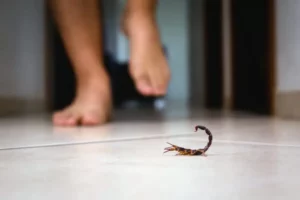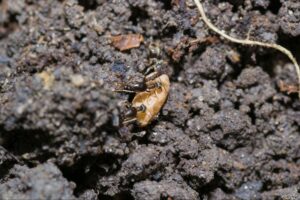Home / Blog / bugs / Why Are There So Many Ladybugs This Year?
Why Are There So Many Ladybugs This Year?

Scientifically reviewed by Rachel Maldonado
-Published on September 16, 2024
-Updated on December 3, 2025
Why is it that some years, as summer winds down, your home seems to turn into a hotbed for ladybugs? This question is voiced by countless homeowners all over the country—especially in the autumn.
Sure, we love ladybugs—when they’re outside. Ladybugs are generally considered harmless, beneficial members of the garden. And it helps that they’re sort of cute, with little black dots on their round, red body. The problem is that when they come inside the house in polka-dotted droves, they become less cute and more irritating.
Why Are There So Many Ladybugs This Year?

A ladybug invasion can usually be attributed to a combination of environmental factors and ladybug reproductive cycles.
They thrive in warm and humid conditions, which means that a mild winter or an early start to spring often results in higher survival rates for ladybug larvae, leading to increased adult populations.
Warm weather also contributes to the availability of aphids and other pest species—their primary food source—which helps fuel their numbers, since plentiful food supply allows for both rapid breeding and successful development.
Why Ladybugs Are Problematic
You’re probably thinking what we were thinking—what’s so bad about ladybugs? And while one or two ladybugs might be a charming surprise here and there (some people might even consider them lucky) a swarming and multiplying infestation can be anything but.
Ladybugs can actually be quite invasive guests. Those bulbous little insects can find their way into every nook and cranny of your home, and once they’re in, getting them out can be a real headache. They congregate in large numbers, causing an eyesore and feeling unmanageable.
What’s more, in those large numbers, ladybugs can actually trigger allergic reactions for some people. Their biological compounds and whatever pollen they’re carrying on their tiny feet from outside can cause eye irritation, respiratory issues, and even skin rashes.
Then there’s the smell. Yes, those tiny, sweet, polka-dotted pests have a scent. When disturbed, ladybugs release a yellowish fluid that has a strong odor. This fluid can also stain surfaces in addition to leaving a lingering scent in your home.
In short, we love ladybugs, but we definitely want to keep them out of the house, not in.
Telling the Difference Between Ladybugs and Similar Pests
Ladybugs—sometimes also known as ladybird beetles or just lady beetles—are scientifically known as Coccinellidae. Not all tiny red beetles are ladybugs, and mistaking which is which can lead to ineffective pest control measures.
Asian Lady Beetles
Asian Lady Beetles are often mistaken for the common ladybug. But Asian Lady Beetles are slightly larger, and have a more pronounced “M” or “W” shape on their pronotum (the area behind the head). They are more invasive pests because they are more aggressive and can bite.
(Ladybugs can bite too, but their bite is usually harmless to humans. They can’t really break our skin, and aren’t known to transmit any diseases or parasites.)
Carpet Beetles
Carpet beetles are also mistaken for ladybugs. But they don’t have the pretty red color we associate with ladybugs; they are typically brown or black, with white spots. Unlike ladybugs, carpet beetles can damage fabrics and furniture—in keeping with their name, they feed on natural fibers like wool, cotton, silk, and leather. Their larvae are the main culprits, whose consumption of these materials creates holes, sometimes causing irreversible damage.
Boxelder Bugs
Boxelder bugs like to infest the home and congregate in large groups during the fall months, just like ladybugs. They are also black and red, but it’s their body that’s black, with red lines on their wings. While they don’t damage property, they’re still a nuisance and an eyesore if they find their way indoors.
Why Ladybugs Come Inside in the Fall
Ladybugs seem to love landing on your doorframes, windowframes, and home exterior during autumn more than any other time of the year. And of course, they naturally find their way inside! Why autumn? This is because ladybugs, like many other beetles, are cold-blooded creatures. When autumn chills set in, they look for warm places to hibernate. Your cozy home becomes their five-star resort.
In their search for the sun, ladybugs seem to be attracted to light-colored homes and illuminated areas. They’re particularly fond of south-facing walls and window corners that get plenty of warm sunlight. If anywhere in your house fits this description, congratulations, you’ve won the ladybug lottery.
How to Prevent a Ladybug Invasion
Now that you know why ladybugs are invading your home, let’s talk about how to prevent them from doing so. Ladybugs are masters of infiltration. They can enter through the tiniest of cracks and crevices. Windows, doors, and even small gaps in your foundation can be entry points.
To prevent their entry, start with the basics:
- Seal Entry Points: The first step is to tightly close any potential entry points. Check your windows, doors, and foundation for gaps and cracks. Use caulk or weatherstripping to seal them up. It might seem labor-intensive, but a little effort now can save you a big headache later.
- Use Screens: Install fine-mesh screens on windows and vents. This will allow you to open the windows to enjoy fresh air without inviting ladybugs inside. Make sure your screens are in good condition and free of holes.
Don’t Put Up With Extra Ladybugs This Year
From triggering allergies to leaving behind unpleasant odors, these tiny beetles are best kept outside. If your home is overrun by ladybugs, contact Hawx Pest Control for our comprehensive Outdoor Pest Control Services.
Related Articles
Visit our blog to learn more.
→







